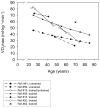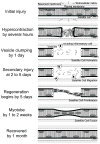The aging of elite male athletes: age-related changes in performance and skeletal muscle structure and function
- PMID: 19001883
- PMCID: PMC3928819
- DOI: 10.1097/JSM.0b013e3181845f1c
The aging of elite male athletes: age-related changes in performance and skeletal muscle structure and function
Abstract
Objective: The paper addresses the degree to which the attainment of the status as an elite athlete in different sports ameliorates the known age-related losses in skeletal muscle structure and function.
Design: The retrospective design, based on comparisons of published data on former elite and masters athletes and data on control subjects, assessed the degree to which the attainment of elite and masters athlete status ameliorated the known age-related changes in skeletal muscle structure and function.
Setting: Institutional.
Participants: Elite male athletes.
Interventions: Participation in selected individual and team sports.
Main outcome measurements: Strength, power, VO2max, and performance.
Results: For elite athletes in all sports, as for the general population, age-related muscle atrophy begins at about 50 years of age. Despite the loss of muscle mass, elite athletes who maintain an active lifestyle age gracefully with few health problems. Conversely, those who lapse into inactivity regress toward general population norms for fitness, weight control, and health problems. Elite athletes in the dual and team sports have careers that rarely extend into their 30s.
Conclusions: Lifelong physical activity does not appear to have any impact on the loss in fiber number. The loss of fibers can be buffered to some degree by hypertrophy of fibers that remain. It is surprising that the performance of elite athletes in all sports appears to be impaired before the onset of the fiber loss. Even with major losses in physical capacity and muscle mass, the performance of elite and masters athletes is remarkable.
Figures







Comment in
-
A growing concern: the older athlete.Clin J Sport Med. 2008 Nov;18(6):477-8. doi: 10.1097/JSM.0b013e3181862a4d. Clin J Sport Med. 2008. PMID: 19001880 No abstract available.
References
-
- Brooks SV, Faulkner JA. Skeletal muscle weakness in old age: underlying mechanisms. Med Sci Sports Exerc. 1994;26:432–439. - PubMed
-
- Brooks SV, Faulkner JA. Effects of aging on the structure and function of skeletal muscle. In: Roussos C, editor. The Thorax. New York: Marcel Dekker, Inc; 1995. pp. 295–312.
-
- Faulkner JA, Brooks SV, Zerba E. Muscle atrophy and weakness with aging: contraction-induced injury as an underlying mechanism. J Gerontol A Biol Sci Med Sci. 1995;50 Spec No:124–129. - PubMed
-
- Faulkner JA, Larkin LM, Claflin DR, et al. Age-related changes in the structure and function of skeletal muscles. Clin Exp Pharmacol Physiol. 2007;34:1091–1096. - PubMed
-
- Akima H, Kano Y, Enomoto Y, et al. Muscle function in 164 men and women aged 20–84 yr. Med Sci Sports Exerc. 2001;33:220–226. - PubMed
Publication types
MeSH terms
Grants and funding
LinkOut - more resources
Full Text Sources
Medical

